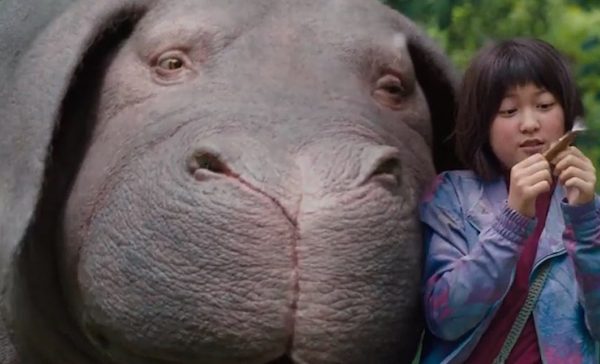
On the day we caught Okja, the latest, Netflix-produced film by superstar Korean director Bong Joon-ho, my girlfriend and I went to a tonkatsu place we’d been meaning to return to — deliberately eating before the screening, not after. Everything we knew about the movie, posters for which went up in our neighborhood in Seoul months before it opened, suggested that we’d leave the theater after this tale of a girl and her giant, genetically enhanced pig with our desire for pork greatly diminished. Still, anyone familiar with Korea has to suspect that no movie, no matter how heartwarming, could take much of a bite out of this heartily carnivorous country’s formidable meat consumption.
Reports have it, though, that both Bong and Okja‘s young star Ahn Seo-hyun went vegetarian during production. At least they did during the shooting of the film’s final scenes set in a vast slaughterhouse for giant pigs, or rather Superpigs, that being the trade name under which the film’s evil corporation plans to market the titular Okja and her cheap, delicious brethren. The story opens in 2007, with that evil corporation — Mirando, certainly not to be confused with any other three-syllable multinational agricultural-product concern beginning with M — announcing a contest: having fortuitously discovered the Superpig, they’ve sent trial Superpiglets to every corner of the Earth, and in 10 years’ time will check back to see which country has managed to raise the biggest and most robust specimen, the key to solving humanity’s looming food crisis.
Korea-studies academics have already begun their field day over the culturally telling aspects of the film, beginning with how it treats almost as a foregone conclusion that the most impressive of the Superpigs would come from the Korean countryside. There, up on a mountain, lives 14-year-old Mija, her farmer grandfather, and Okja, who weighs seven tons and whose porcine features look hybridized with those of a dog and a hippopotamus. But their rural idyll shatters on the day, a decade after the first scene, when the Americans from Mirando huff, puff, and sweat their way up the steep trail to the family home (clearly no such challenge to the hardy septuagenarian in residence and his young charge).
Read the whole thing at the Los Angeles Review of Books.